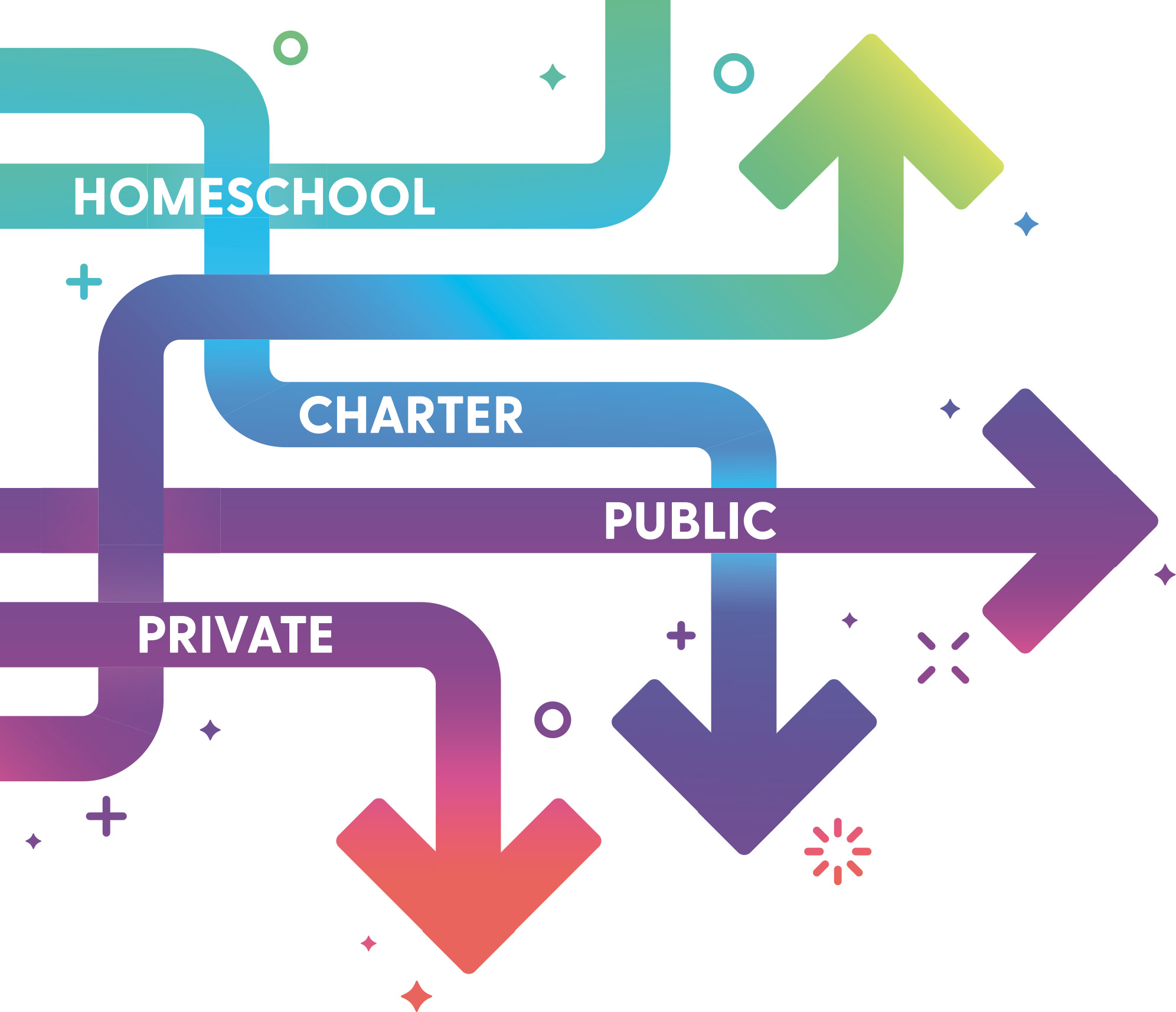

The experience in Natomas USD reflects that of many districts around California — and what the pandemic may be accelerating as families become comfortable with distance learning or try to find alternative in-person instruction options. In the last decade, local educational agencies in 30 of 58 California counties lost enrollment (a total of 230,000 students), with 11 counties losing 10 percent or more of their student base, according to a study released in February 2020 by the Public Policy Institute of California. Over the next decade, 31 counties are projected to see enrollment declines, for a total of 478,000 students. While some factors — such as families moving due to rising cost of living in many areas — are out of an LEA’s control, districts and county offices of education can make strides in retaining current students and attracting new families through marketing efforts.
Declining enrollment is not just an issue in California. The past 20 years have seen sluggish growth for traditional public schools across the United States. A September 2019 U.S. Department of Education report, “School Choice in the United States: 2019,” found that from 2000 to 2016, enrollment in traditional public schools grew by just 1 percent; in that same time frame, charter enrollment increased by more than five times. In California, about 10 percent of students attend a charter school. The report found that 41 percent of parents surveyed in a national sample say that school choice was available to them.
Pleasant Valley School District Board President Rebecca Cramer has studied how parents make these choices about schools. “We need to understand that our neighborhood public schools face this competitive environment,” Cramer said. “It’s not something that we’ve prepared administrators or teachers or principals to do. It’s not a typical part of education. You don’t get training in being a marketing expert or how to sell your school — and that’s how I got involved in researching this topic academically. School choice is growing and COVID has accelerated this trend nationwide.”

Santa Clara USD Director of Communications Jennifer Dericco said there are many reasons to market a basic aid district such as Santa Clara. “Even though we aren’t reliant on the revenue from enrollment, we market because we want our parents to see our schools as schools of choice,” she said. “We want them to feel confident that we will make good on our district vision. We also have one of the largest bond programs in the state and we need to make sure that our voters trust us and have confidence to support our school district when we need to go back to the ballot to improve our school facilities. Lastly, we want to make sure we are attracting and retaining the most qualified staff so that we can make good on our district’s vision for student success.”

Once you have surveyed your digital landscape, there are several ways to get additional feedback from stakeholders. “If possible, talk to your district’s parent groups,” said Cramer. “Harness the power of your PTA parents who would be willing to talk about these things openly. Look to your parent advisory groups as well.”
When Natomas USD began surveying its digital footprint, it found that charter schools had a lot more information readily and easily available to the community. The district started marketing by creating simple elements like fact sheets on their school programs and making them available on campuses and at community events. The district’s public information officer amped up their social media presence, pitched inspiring school programs and stories to reporters, and began monthly community newsletters that highlighted different school programs and community partnerships. The district also used data to analyze when they were losing students and surveying parents to find out why.
“We immediately started growing our enrollment in the midst of a flood moratorium,” said Kaplan. “We found we were losing kids to charters in fifth grade and high school. So, when we started highlighting the different specialty programs that we had, we started seeing parents stay with our district or choosing our middle school options.”
The district was facing declining enrollment due to new charter schools in the district’s boundary, and rising housing costs that were driving many middleclass and low-income families from the area. Low rankings on GreatSchools.org further contributed to the erosion of RCSD’s potential student base as many new families moving into the area chose private schools or moved to neighboring communities with higher test scores when their young children reached school age. The district began surveying current parents and found satisfaction levels were high, but when they surveyed potential kindergarten parents, they found a lack of confidence in RCSD due to class sizes, funding, test scores and other factors. Naomi Hunter, then the district’s communications professional, noticed that most parents of children enrolled in the district were really happy with them. “One of the key things in marketing is to draw on what you know about the people you’re marketing to,” said Hunter. “I noticed that the people who were open enough to enroll their kids in a school that was not necessarily ranked highly but they enrolled their kids, they took the chance — and they fell in love with the schools.”
From there, the slogan was born: Meet, Choose, Love RCSD. The campaign features printed materials about what the district has to offer; a videographer was hired to highlight school programs and staff, students, and the fun that can be had at school. They showed the videos everywhere they could — before board meetings, at festivals, on social media and even as a commercial in local theaters. After continuing surveys year to year, especially during kindergarten roundup nights to see what parents are looking for, the campaign continues to attract more families to choose RCSD.

Once you have gathered your information and know what your community is looking for, districts need to analyze the information. Do you have programs that fit local needs — but your community isn’t aware of them? What initiatives from community feedback can be implemented with current LEA resources?
PR pro Hunter echoed this advice and took it a step further. “Training all of your staff, your principals, your front office staff in particular, on how to answer tough questions is really valuable,” she said. “That doesn’t necessarily feel like marketing, but it’s a really important part of it. For example, in our community, a lot of parents would ask, ‘How will my child learn if they go to school with a high number of English language learners?’ There are really good answers for that question that might make you want to send your child to that school — but if a principal gets that question and they haven’t been given any support in how to answer it, they might lose an opportunity.”
Another tip? “Know who your local education reporters are,” said Cramer. “Make sure that you either send them emails or press releases or whatever it is they like to see about stuff your schools are doing.”
Another way for districts to market their successes and programs — even without a dedicated communications person — is through existing community partnerships. For example, the Nevada City Joint Union High School District in the Sierra foothills does not have communications staff. What it does have is a robust community scholarship program. Scholarship Coordinator Linda Melugin said the district has more than 165 different donors for around 300 scholarships. “We essentially had organic marketing right there,” Melugin said. “We have over 165 people that already give us money, they’re already supporting us and they serve on different platforms in the community. They’re our talking heads and if we treat them as partners, they will have ownership in our district and in our community.”
The district began sending e-newsletters with special branding for the partners to make them aware of successes, challenges and events. “We try and make our donors and our community partners feel as though they have a voice in our districts because at the end of the day, they do, they’re tax paying citizens,” said Melugin. “It’s worked out well for us because now we have these ever-growing partnerships, these people feel valued, they feel like they have an investment in the school district and they feel communicated to, we update them constantly and they can get that information out to their own communities.”
Melugin noted there are many ways in which districts work with their communities, not just scholarship programs. “Career technical education has some of the same concepts as the scholarship program,” she said. “You have these industry partners from your community that make up your different pathways or your CTE courses. And again, these are people that already believe in you, that already support you because they’ve signed on to be an industry partner or they’ve signed on to serve on your advisory board — make them your talking heads. All you’re going to do is send an extra email. All you’re going to do is retitle a newsletter to make it fit the CTE world or to the sports world. Sports and visual performing arts are other examples where you might have sponsors or other outside professionals in those worlds.”
Every LEA — large or small, urban, suburban or rural — should at the very least be aware of the information available to their communities about them. The pandemic has increased digital communications and, in many cases, the accessibility of an LEA to its constituents. “I think there is an opportunity right now for public schools across California to help strengthen the identity and capacity of themselves at a district level,” Cramer said. “That’s a good thing for neighborhood public schools.”
Kimberly Sellery is managing editor for California Schools.